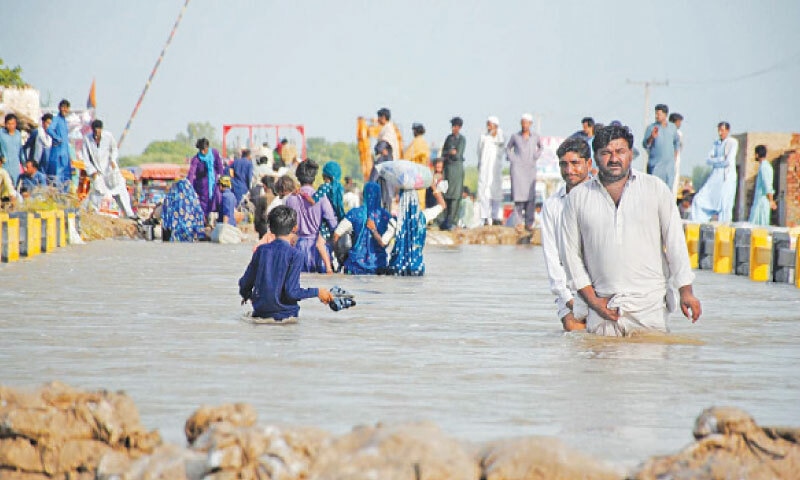SANGHAR/MIRPURKHAS: Rows of improvised tents dot rural Sindh, devastated by successive spells of torrential monsoon rains since July. But Wali Kohli is determined to face the havoc wrought by extreme weather conditions this summer.
At 7:30am, she is ready to prepare food for her husband, Ganga Ram, and children out of the wheat flour her husband bought. Wali was, however, worried about her buffalo that sits paces away on a roadside facing an irrigation channel. “It is sick and supposed to deliver a baby,” she said while kneading the wheat flour.
Her house made of thatched straw has already caved in. Its remains are surrounded by muddy rainwater. She lives in a village located on a landowner’s farmlands she tills with her husband. “Nothing is left. We can’t enter our home so we struggle to face these conditions,” Wali states.

Districts in lower Sindh are facing massive devastation, miseries and pain. Monsoon rains have affected millions. But thousands of peasants, including women and children, are the worst hit and homeless. Wali and many others like her have been living under the open sky with no immediate end to their miseries.
They have temporarily settled on roadsides in their respective towns ever since rains wreaked a catastrophe for this marginalised section of society. These are in addition to those staying in relief camps in urban centres.
Agricultural fields and villages are fully submerged in these districts. “Destruction of the cotton crop means we won’t be able to pick cotton. I will be looking for alternate labour to make both ends meet,” says Ganga.
The displaced communities are dependent on food provided by philanthropists or local organisations. Scenes of flood victims chasing vehicles distributing food are now common.
Villages are mostly located on farmlands that are now completely submerged. Their inhabitants wade through rainwater to grab necessary items that have remained safe from the heavy rains and bring back to their makeshift tents.

“Do you think we are sitting on roads out of pleasure?” asked an elderly Hamraj Bheel in Jam Nawaz Ali taluka. Around 70 mud houses in Hamraj’s village have collapsed. “We spend sleepless nights because of mosquitoes, and our animals are in pain too,” he argued.
Flood victims burn wild bushes and wood to produce smoke to keep mosquitoes away from them and their cattle. Animals are an important asset which they sell in such dire times.
“I cherish my cattle more than anything as it helps me eke out a living,” says Cheetan Kohli in Sanghar. His community fellow, Ramo Kohli, points out they have been leading a miserable life for a week. “They [women] go somewhere nearby to defecate. There is no other option as our village is totally inundated, otherwise what is the need for sitting here on the road,” argued Ramo. “We don’t know where the government aid goes. Nobody comes to us, except a few,” he complained.
These communities apparently prefer staying on the road near their village instead of relief camps. Their cattle are a major factor that prevents them from moving into camps. “Somehow, this remaining fodder in the field is cut to feed my animals,” said a female peasant.
The Sindh Provincial Disaster Management Authority (PDMA) in its Aug 25 report put total casualties at 339 and 974 injuries. Among the dead were 117 men, 46 women and 108 children, while 98,260 cattle had perished, and 191,030 houses were fully damaged and 395,080 partially.
According to the PDMA, over 4.9 million people in Sindh were affected. It claimed the National Disaster Management Authority (NDMA) was providing relief to the PDMA in terms of 3,880 ration bags, 3,600 mosquito nets, 4,900 plastic tarpaulin, 4,835 tents and 95 dewatering pumps.

Those like Cheetan Oadh who have alternate places in the less-affected districts are opting for short-term migration. Oadh is travelling with his 15-member family in a vehicle on the Tando Adam-Mirpurkhas road. “We are going to Umerkot as my brick kiln workplace is entirely submerged in rainwater,” he says.
Jhuddo town is the worst hit besides Tando Jan Mohammad in Mirpurkhas. “People from Jhuddo are migrating,” said Manoj Kumar, a local resident. Like several others, he was present at the RD-305 of the spinal drain of the Left Bank Outfall Drain (LBOD) system to see if the water levels in the drain are dropping. “There is around 2.5 feet of water in every street of Jhuddo,” he added.
The accumulated rainwater in different towns of Mirpurkhas is disposed of in the LBOD, which has now peaked. The Naukot Jhuddo road remained completely flooded at RD-305. Even the bridge over the LBOD is under 2.5-foot water, disconnecting the land route between Mirpurkhas and Tharparkar.
The spinal drain has, luckily, not developed a breach, unlike the 2020 rains when a few breaches occurred in it in Mirpurkhas and Badin districts, inundating areas right up to Kaloi in Tharparkar. Districts such as Badin, Sanghar and Mirpurkhas were facing a drainage issue. Agricultural runoff following the monsoon rains is usually disposed of in sub-drains of the LBOD.
Irrigation officials along with local labourers are struggling to protect the main embankment of the spinal drain — currently carrying 10,000 cusecs against a capacity of 4,000 cusecs — by raising its height through stacking of gunny bags. Once the LBOD starts disposing of rainwater at zero point, water levels in towns would also start receding.
Published in Dawn, August 28th, 2022















































